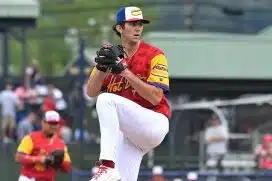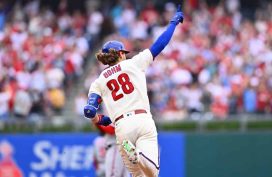By: Jason Ferrie, Sports Talk Philly Columnist
A major key to a winning major league team is how they manage the back-end of their games.
This season the Philadelphia Phillies find themselves in what most would describe as a good position with the additions of Joaquin Benoit and Pat Neshek—both long-time major league relievers. In addition, the Phillies bring back Hector Neris, Edubray Ramos and Jeanmar Gomez—who all had their own success for Philadelphia in 2016. With these five relievers expecting to see significant innings this season, how exactly will manager Pete Mackanin handle this bullpen?
Here is a breakdown of the top-five right-handed arms in the Phillies bullpen:
|
Name |
Games |
Innings |
ERA |
FIP |
xFIP |
K% |
BB% |
Holds |
Saves |
Blown Saves |
Inherited Runners |
Inherited Runners Scored |
|
Pat Neshek |
60 |
47 |
3.06 |
3.68 |
4.07 |
23.20% |
6.00% |
18 |
0 |
0 |
31 |
11 |
|
Joaquin Benoit |
51 |
48 |
2.81 |
3.9 |
4.24 |
25.50% |
11.80% |
18 |
1 |
3 |
11 |
8 |
|
Edubray Ramos |
42 |
40 |
3.83 |
3.6 |
3.68 |
25.00% |
6.90% |
15 |
0 |
2 |
17 |
3 |
|
Jeanmar Gomez |
70 |
68.2 |
4.85 |
3.96 |
4.26 |
15.80% |
7.40% |
1 |
37 |
6 |
11 |
2 |
|
Hector Neris |
79 |
80.1 |
2.58 |
3.3 |
3.17 |
31.10% |
9.20% |
28 |
2 |
4 |
20 |
4 |
Some of these numbers may take a second to sink in, but it is clear Hector Neris was the best of this group last season. Now that doesn’t guarantee that he will be the best this season, but the advanced numbers like FIP and xFIP that we can use to predict regression were also better than the remaining four arms. Baked into those numbers is the fact that Neris was a strikeout artist last season, finishing with a 31.1-percent strikeout rate and one of eight relievers with 100 or more. I am not a huge fan of the manager naming a closer because it comes along with the notion that they will solely throw the ninth and sometimes touch the eighth inning, so I’ll call Neris the bullpen ace.
Trending: Dallas Green – A Baseball Life
In his role, Neris should be used similarly to the way the Yankees use Dellin Betances. When you need an out in a tight situation, Neris is the reliever you want on the mound. He has been dominant to both sides of the plate, holding left-handed hitters to a .208/.288/.344 slash and a .191/.273/.333 to right-handed hitters. Neris even had a greater strikeout rate against left-handed hitters at 32.2-percent compared to 29.8-percent to right-handed hitters. He may not be close games, but it is fair to say Neris should be the bullpen ace.
Edubray Ramos is probably the least recognized name of the five right-handed pitchers I have listed, but he brings a 95 mile-per-hour fastball with him. The issue was that pitch was the one that gave him the most issues last season, allowing a .321 batting average and .488 slugging percentage. The large majority of his fastball related issues came against left-handed hitters, who hit .348 with a .587 slugging percentage against the young right-hander. Ramos features a slider that was very successful—holding left-handed hitters to a .143 batting average and .357 slugging percentage in a just 28 at-bats ending with a slider. Right-handed hitters also had issues with Ramos’ slider, hitting .151 with a .212 slugging percentage and no home runs in 33 at-bats ending with the pitch.
Ramos is going to see a lot of action this season and if I had to make a guess, I would say he and Neshek, who we will get to, will be the first arms of the five arms out of the bullpen. It is probably safe to pencil Ramos in for 55 games this season. A part of his growth could rely on the development of a third pitch as he was fastball and slider dominant in 2016.
Pat Neshek is a veteran the Phillies acquired this past off-season and he brings a unique delivery and consistency to the bullpen. In looking at the metrics, you can see that Neshek greatly out performed his FIP and xFIP this past season. In fact, he has done this just about every season since 2010. Neshek will be the veteran the Phillies turn to when they get into a jam—but that is something he is used to as he inherited 31 runners last season. While he allowed 11 of those runners to score — the most he has allowed since 2007 when he inherited 59 runners — the veteran presence of handling those situations is something Mackanin will value. It will be very interesting to see the pitch distribution that Neshek goes with this season as he has flip-flopped between being a sinker and slider heavy pitcher the past few season. As previously mentioned, Neshek will be one of the first of this group to come into the game.
Popular: We appear to be witnessing the end of Jimmy Rollins' career
The other new addition, Joaquin Benoit, has been around the league since 2001, making a name for himself as a very good reliever in Detroit and San Diego. Benoit is very familiar with the late innings—registering 18 holds between Seattle and Toronto last season. During his time in Detroit and San Diego, the newly acquired Benoit registered as many as 30 holds in a season. Surprisingly, Benoit has only registered ten or more saves in a season on two occasions. Mackanin won’t have Benoit as the closer on Opening Day, but he is going to be used in the eighth inning a lot for the Phillies. He provides the opportunity to use Neris in that Betances type role while having experience at the back-end of the bullpen. Benoit has done a decent job the last couple of years holding left-handed hitters in check—allowing just a .377 and .375 slugging percentage against.
Likely, the Phillies will open the season with Jeanmar Gomez as their closer. While I am not sure Gomez will hold this role for the entire season, he did manage to save 37 games a season ago. Last season was really a tale of two halves for Gomez as he held opposing hitters a .232/.283/.355 slash line in the first half. Along with that, he induced weak contact on nearly 25-percent of the balls in play.
The second half wasn’t so pretty as Gomez allowed a .356/.420/.500 slash line to opposing hitters and drew weak contact on 17-percent of balls in play. The second half did feature a .415 batting average on balls in play—which is very high, especially for the ground ball heavy Gomez. A big factor in Gomez's success last year was the double-play ball as he induced ten of them—which was tied for tenth most in the majors. The issue for Gomez is that he doesn’t strike out a ton of batters. Out of the five Phillies pitchers discussed, Gomez has the lowest strikeout rate at just 15.8-percent.
I don’t think that Gomez is a bad major league pitcher, I just don’t think he is going to be as good as he was early in 2016, but that won’t stop him from being the closer on Opening Day for the 2017 Philadelphia Phillies.
In the end, this is a pretty good situation for the Phillies between their newly acquired veterans and trio of right-handed arms from last season. Mackanin finds himself in a situation where he can and should be flexible with his big arms. If Mackanin and manages these right-handed arms well and uses them in the situations they should be used in this season, the Phillies bullpen could buy them a few games that could matter come the end of the season.







